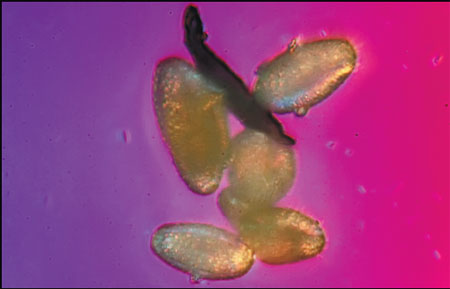

It has been two years since China Daily last interviewed 31-year-old Zhang Chao. The Beijing-based micrograph enthusiast still wears the same hair style, even the same coat.
But one thing is very different: He's become a celebrity in cyberspace almost overnight, after his pictures, which depict what the rampant smog in Beijing looks like under his microscope, spread like a virus on China's major micro-blogging site Sina Weibo, since he posted them last Friday. Now the media is hounding him for interviews.
"Why do I become famous when I took pictures of the smog?" he asks with a wry smile. "I have taken numerous pictures of beautiful nature whenever I have spare time, but there are no more than 10 interview requests for me every year before. Now, I have to answer dozens of phone calls from media every day.
"But I only gained 2,000 more followers over the weekend. I guess the micro blog is not as popular as before," he says, jokingly.
On Monday morning, a camera crew from a TV station based in southern Hunan province even took a flight to Beijing just to record how Zhang takes pictures of the Beijing's most-talked about feature: the floating enemies in the air.

The process is not complicated: He puts microscope slides on his windowsill and collects the samples covered by fallen dust after 10 hours.
Zhang's apartment is on the eighth floor, which he says is perfect for capturing the densest levels of smog.
As a Beijing native, Zhang explains his original purpose is to "deconstruct" Beijing's smog and unveil its shroud of mystery.
"People have higher and higher standards for the environment," he says. "When I was a child, I was annoyed by the frequent sandstorms, so I feel Beijing's air seems much better now all in all because there are hardly any sandstorms in recent years. Now, we've noticed PM2.5, which has long been neglected."
Although he graduated as a science major from Beijing Normal University, Zhang says it is difficult for him to give an exact definition of what smog is in Beijing. "It's too complicated, and its ingredients keep changing."
Under his scope, which magnifies the sample 1,000 times, the smog is found to contain minerals, fragments of animal fur and insects, seeds and burnt dust. But many are compounds, he says, which are more difficult to identify.
"I wanted to know if there are many pollen grains in the early spring's smog, and my guess turns out to be right," Zhang says, noting there are on average 10 pollen grains found on each slide.
"Though the number is low compared with other ingredients of smog, it may partially explain why smog makes us feel uncomfortable because many people are allergic to pollen."
Zhang realizes that he may have disappointed the public because he can't show the inner construction of PM2.5, today's most notorious element in smog. It is beyond the capacity of his microscope and camera to explore such tiny grains.
Working as a freelancer and editor for an astronomy magazine affiliated with the National Astronomical Observatories of the Chinese Academy of Sciences, his regular job is to stare at the starry firmament and write popular-science articles. However, he is proud to have stirred equal interest by observing the micro world.
"You cannot imagine how splendid the micro world is until you fall in love picturing bugs in the garden, different kinds of sand grains, or some tiny corners in our daily lives.
"My favorite is to shoot snowflakes. I would love to compile my snowflake pictures to publish a book. But you know how much warmer Beijing was in the past winter - I should have traveled to northeastern China to get more pictures."
wangkaihao@chinadaily.com.cn
 |
|
A picture of smog particles under the microscope taken by Zhang Chao. Provided to China Daily |